Wildlife Removal Blog 2007
This weblog chronicles some of the adventures I have had while operating my wildlife removal company in Orlando, FL - Click any of the photos for a larger image and more information.
I currently have 351 blog entries. You can select them sorted as such:
2003 •
2004 •
2005 •
2006 •
2007 •
2008 •
Armadillo •
Bat •
Bird •
Dead •
Opossum •
Rat •
Snake •
Squirrel •
Others •
Repairs •
All Entries
12.15.2007 - Raccoon Under House
 |
|
| Raccoons are opportunistic creatures who love to live in urban areas and neighborhoods. They take advantage of any space they can find a good, dry, safe
home. Trees are in short supply, but houses aren't! Many homes have raised decks or are elevated with crawlspaces underneath. Many wild animals are attracted
to such areas, which are protected from the weather. It's common for raccoons to choose to set up shop under the house. Most of the raccoons under homes are
solitary raccoons, or males. Female raccoons who have young like to ...click for more |
12.08.2007 - Florida Water Snake
 |
|
| Here is a fine specimen of a Brown Water Snake, (Nerodia taxispilota). This snake is supposedly common in some areas, but I've found only a few during my time as a nuisance wildlife trapper here in Orlando Florida. This snake is, like
pretty much all aquatic snakes, heavy-bodied in comparison to most snakes. Part of the reason for the body shape is because of the buoyancy needed for waterbound critters. I'm surprised that these snakes don't have any sort of a paddle-tail, but they don't. They swim
just fine, moving along the surface of the water via ...click for more |
11.11.2007 - Raccoon Drawing
 |
|
| A couple of years ago I rescued a baby raccoon, as I commonly do. I put the photos of this raccoon on my website, as I also commonly do. The photos are located here cute baby raccoons if you want to see them.
Anyway, a nice lady named Susan Smith wrote to me and asked if she could use my photos as inspiration to paint some wildlife pictures, and I said of course. I thought nothing of it until months later, when she emailed me a nice scan of a painting that she
made out of one of my photos. I have put her painting and the original photo side by side for compar ...click for more |
11.02.2007 - Rat Poison Is a Bad Idea
 |
|
| I say it again and again on my websites and in many of the blog pages that I've written about rodent control, but I just want to outline once and for all the many reasons why the use of rat poison is a terrible
approach to rat control. Poison is ineffective - Yes, poison does kill rats. But it does not kill all of the rats. Only 100%
eradication is acceptable in rat control. If you leave just a few, your problem is just as bad as it ever was, because rats reproduce so quickly. The thing about
poison is that not all the rats will eat it, and of those that eat it, not all will die. ...click for more |
11.01.2007 - Bird Spikes for Pigeon Repellent
 |
|
| Pigeons love to roost on store signs. This is a very common problem in urban areas. Signs such as the one in the above photo provide a
suitable ledge for the birds to establish nesting areas. Oftentimes these signs are in mini-malls or other areas with ready access to food, such as from nearby
restaurants and people. Of course, no shop owner wants pigeons roosting on his or her store sign. The birds make quite a mess with their nesting material,
feathers, and of course, droppings. You can see some small accumulations of pigeon poo on the sign above, and a lot ...click for more |
10.23.2007 - Bat Extermination
 |
|
| Today I went to a commercial building, a large department store, with thousands of healthy bats flying in and out. Months earlier, the store had hired their normal pest control company to take care of the bat
problem, and they sprayed the bats and the area with bug poison. I found about ten bat carcasses outside. Some of the old/frail had died. The vast majority lived, and the problem persisted, and so they decided to hire me
to take care of the bats correctly. Let me get it right out to anyone who found this post in a search for a means of bat extermination - AN ATTEMPT ...click for more |
10.22.2007 - Eastern Coral Snake
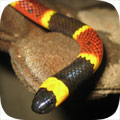 |
|
| This is a close up photo of an Eastern Coral Snake, Micrurus fulvius, that I caught. I'm holding it with thick
gloves. Yes, this snake is a member of the elapid snakes, a family that includes cobras, and it has a very powerful neurotoxin venom that can be fatal to people. However,
this snake is not very aggressive, and as you an see, it has a tiny mouth. It also has small fangs, and it can't inject venom the way the pit vipers do. The venom delivery is
slower. Thus, it's fairly safe to handle with thick gloves and a knowledge of how it can move and what it can do. I of course ...click for more |
09.26.2007 - Raccoon in the Soffit or Eave
 |
|
| Here's a photo that I took yesterday of a raccoon just as it was about to re-enter this house. You can see that it's torn open a hole in the soffit.
This is a very common entry point for raccoons. The eaves of the homes often meet other parts of the roof, and the soffit is right there. It's usually made of
flimsy aluminum or vinyl, and it's a cinch for raccoons to tear it open. This hole leads right into the attic of the home, where the raccoon has set up a nest.
Sometimes the raccoons live in the soffits or eaves themselves, or make their nest down in the soffit, where it's ...click for more |
09.22.2007 - Giant Rat - Big Norway Rat in Seattle
 |
|
| This photo was sent to me by my brother-in-law Sean, who I trained, and who now operates his own wildlife removal business in Seattle, WA. It's of a giant Norway Rat, or "hog rat" as he called it. I've gotten some very large rats myself here in Orlando Florida,
but none as big as this beast! Norway Rats are, on average, larger than the Roof Rats, or Black Rats, that I deal with. Most striking to me is the short, fat tail of this Norway Rat. Roof Rats have very long, black, sleek tails that are longer than the body length. This is probably
because Roof Rats require more balan ...click for more |
09.19.2007 - Pigeon Poop - Droppings & Waste in Attic
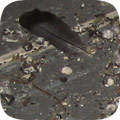 |
|
| I did a pigeon removal project at this residential house. The homeowner heard noises in the attic. At first he thought that he was hearing
rodents, such as rats or squirrels. However, one look at the evidence shown above, and I knew that I was dealing with a pigeon infestation. Pigeons love to
live in attics, just like other wild animals such as raccoons or mice. And just like any animal that lives in an attic, they leave their waste behind. In the
above photo, we see some of the remnants of the pigeon presence - the pigeon poop. As with any wildlife job, first thing ...click for more |
09.12.2007 - Dead Mouse in the House / Ceiling
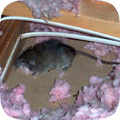 |
|
| Thanks to your website, I was given some good info
that allowed me to locate a rotting dead mouse in my attic. I was thrilled not to have to pay someone a
bunch of money to do it!I had to cut a hole in my hallway to gain access to
the space above the room where I had previously whiffed out the location of the carcass, just as you
described on your website. Making my way around the walls of the room we knew the smell was coming from, I
finally started on the ceiling and before long, GAG!!, I found the source, and it was just like you
said...leeching through the sheetro ...click for more |
09.09.2007 - Squirrel Detail Closeup Photograph
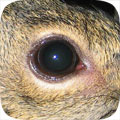 |
|
| This is a closeup photograph of an Eastern Gray Squirrel. I have it in a cage, and although it's hard to take good closeup pictures of squirrels, because
they are so rambunctious and fast, sometimes they will sit still for a period of time and let me take photos. This is a profile shot of the squirrel's head, with my close
camera setting. I have this photo in much higher detail than I posted here online, if you'd like a copy. Note how fur covers every surface, even the inside of the
ears. Also, you can see that it has whiskers, like all rodents. It's also got that tradmar ...click for more |
09.04.2007 - Opossum Teeth - Threat Display
 |
|
| Opossums have the most teeth of any mammal - 50 pointy teeth. When threatened, this slow critter often gapes its mouth open, exposing that mouth full of sharp teeth. It's just a threat display, however, and opossums very rarely bite. It's not that they
lack aggressiveness, it's just that they're too stupid to even manage a bite - seriously! They just stand there with their mouths open. I've shoved thick leather gloves and sticks into this wide open mouth, and the animal does nothing. It doesn't bite. I guess it's just
hoping that any aggressor will just back off at the sight of that ...click for more |
08.15.2007 - Bat Poop - Droppings & Waste in an Attic
 |
|
| The biggest problem with a colony of bats living in the attic is that they poop a lot. If the group of bats is very large, the waste can really build up.
Some colonies of bats are over 1000 members in number. Each bat makes about 6-8 bat turds per day. They live in the attic year-round. That means a lot of bat
crap. In the above photo, a small group of 40 bats were living in an attic. They roosted across the length of the attic ridge, but most of the bats roosted in one
area. Below that lay a pile of bat droppings, or guano, as seen in the above photo. This is a relatively ...click for more |
08.14.2007 - How Do I Get the Bats Out?
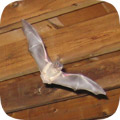 |
|
| Everyone always wants to know how I go about getting bats out of an attic. Well it's a trade secret, so bugger off! What I mean to say is, I trained for two straight years on bat removal projects, and the
variables in any particular job mean that there's no one way to tell a person how to do it. Basically, if you're a do-it-yourself type person, this isn't necessarily a do-it-yourself type project. Go ahead and rewire
your house - you don't need an electrician. Go ahead and cut down that tree - you don't need an arborist. Clogged arteries? Go to Sears and buy the triple bypass kit ...click for more |
08.08.2007 - Pygmy Rattlesnake
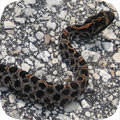 |
|
| Ah, the Pygmy Rattlesnake - one of central Florida's four species of venomous snake. It's supposedly the most common of the four, but I never find them.
I see more Cottonmouths, and I've even caught a few Eastern Diamondbacks and Coral Snakes. This snake is actually the Dusky Pygmy Rattlesnake, Sistrurus miliarius
barbouri. There's a few different species of Pygmies, and they live in the SE United States. I cannot determine if the proper spelling is Pigmy Rattlesnake or Pygmy, but both spellings are used
for the snake. Some people misspell this ...click for more |
07.01.2007 - Squirrel Cage - Trapped in a Cage Trap
 |
|
| Cage traps are a good option for squirrel control. There are lethal traps out there, but there's no need to kill squirrels. They can be live-trapped
and relocated. One-way exclusion doors also do a good job of removing squirrels from buildings, but squirrels sometimes then work to chew their way back into the
building. For successful trapping of squirrels in a cage trap, simply set the proper type of trap in an area you know the squirrels travel, and bait it with peanut butter
and peanuts or seeds. The trap must have the proper pan tension so that a lightweig ...click for more |
06.27.2007 - Eating Rats for Dinner
 |
|
| One of the perks of my job as a rodent removal specialist is that my work yields me free dinner. Some days I don't eat well, but tonight it's a feast! I caught eight plump and juicy rats today, so I'm in for a hearty meal. Many people ask me how I prepare the
rats for eating. Most people seem to think that I skin them, butcher them, and sauté the succulent rat meat in a garlic butter fry. Some have suggested that I probably stuff the rats, put a grape in their mouth, and bake like a turkey. When I caught rats in the Chinatown section,
it was implied that I'd stir-fry or ...click for more |
06.21.2007 - Baby Cottonmouth Photo / Picture
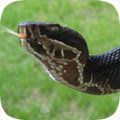 |
|
| This is an important snake to be able to identify in the state of Florida. This is a juvenile cottonmouth snake. As with many snakes, its appearance
is different from that of the adult snake. The young cottonmouth has angular brown and tan bands in a pattern. As the snake ages, these bands fade, and the snake
becomes almost entirely black. The only real identifying coloration marking on the adult is the black band that extends back from the eye. The cottonmouth. or
water moccasin as it's also called, also has an elliptical pupil (see the above eye, how it's cat ...click for more |
05.30.2007 - Eastern Glass Lizard / Snake
 |
|
| This is an Eastern Glass Lizard, (Ophisaurus ventralis), often referred to as a Glass Snake. It is actually a lizard,
but it looks of course, like a snake. It lives mostly in the SE United States, and throughout Florida. They grown up to about 30 inches long, and they eat mostly insects. They
spend much of their time underground, and that's where I caught this one. I was at a customer's house, sealing some holes near the base of the house, and I saw a little bit of
this lizard, and it went under the dirt, and I scrounged it up. I think it is pretty. This reptile got its name from the ...click for more |
05.23.2007 - Oppossum Capture
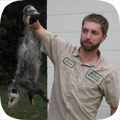 |
|
| Oppossums can hang from their tails. In fact, their tails are prehensile, which means that they can curl their tails and grip objects. They
primarily use this feature to aid in climbing and balancing in trees. The truth is that they rarely actually hang from their tails. There's really no need for it.
However, they can do it if they must, perhaps to catch themselves from a fall. Thus, I am able to hold an oppossum by the tail with no harm to the animal. This
creature is fairly docile. I've seen very few aggressive ones. It's pretty safe to handle them this way. However, I wouldn't ...click for more |
05.18.2007 - Baby Armadillo Photograph
 |
|
| How cute! A baby armadillo! Armadillos aren't normally cute, but the younglings qualify, and then they get less attractive with age (like me!). Armadillos don't breed very often (like me!), and when they do, the young hide in the den and grow quickly. Thus, juvenile armadillos are
rarely seen or caught. However, today we got four juvenile armadillos. Here I am, seen holding the pick of the litter. How did we come across four in just one day? That's a silly question - armadillos ALWAYS have four young! That's right, in a very strange breeding quirk, armadillos
alwa ...click for more |
05.15.2007 - Flying Squirrel Removal
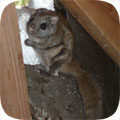 |
|
| Flying squirrels are rodents, like all squirrels. They don't actually fly, but glide on flaps between their front and hind legs. They are nocturnal
animals, and they are colonizing - they live in groups. They usually live in trees, just like the Gray Squirrels, but just like the Grays, they love to live inside of
attics. If you have flying squirrels in the attic, you will notice noise at night, since that's when these animals are active. They will leave the house at dark
and forage, and come back a few times, and retire by morning. They don't make quite as much noise as their larger ...click for more |
05.08.2007 - Vulture Removal & Control
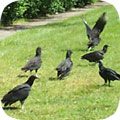 |
|
| Vultures! Those harbingers of death! Those dark-caped masqueraders of the other world! Those connoisseurs of roadkill! Yes, vultures.
These vultures in this photo are not Turkey Vultures Cathartes aura, but rather American Black Vultures Coragyps atratus which are more common
in the south. They are congregating around an armadillo carcass for unknown reasons. Ha, I always wanted to say that. They are actually there to eat the
armadillo carcass for the purposes of nutrition. When they eat the armadillo carcass, they will digest it and then later on they will poop...click for more |
05.06.2007 - Raccoon Removal Company - Wildlife Control
 |
|
| I am usually quite pleased with myself when I am able to find and remove a litter of baby raccoons from a difficult area. This type of work takes a lot of
sleuthing and searching. The customer had been hearing a lot of heavy scurrying and scratching noise in the cathedral ceiling in this room. I saw a big hole in the
roof, but there was no attic space for me to crawl in, because it was a cathedral ceiling (same slope as the roof, no real attic space). Thus, I had to very carefully
listen for any sign of baby raccoons. It would have been easy to simply set a trap and catch a ...click for more |
05.03.2007 - Dead Rat In the Attic - Remove Dead Rodent in Attic
 |
|
| This is a fairly common job: the dead rat in the attic. Rats are probably the most common animal to invade human dwellings (aside from humans, that is), and they have short
life spans and often live in high numbers and are persecuted with poisons and so on and so forth, and so they die inside buildings quite often. Since they tend to live in attics, they also tend to die in attics. Thus, the
most common dead animal removal job I have is the dead rat in the attic. I don't always know if it's a dead rat when I'm called to the scene, but once inside the building, I can definite...click for more |
04.14.2007 - Raccoon Tracks / Footprints
 |
|
| Here are a few different photographs of raccoon footprints that I've taken while doing wildlife control jobs. Raccoons have distinct tracks, and their
hands look somewhat like human hands, with a palm and long fingers. The hind foot of the raccoon is longer, but they tend to walk on the ball of the hind foot, so the
track often looks similar to the front foot. In the upper-left corner are some tracks inside an attic. They were on a section of sheetrock where there was no
insulation. There was a fine dust covering this area, so the tracks were very distinct. I actually saw this ...click for more |
04.13.2007 - Red Rat Snake
 |
|
| The Red Rat Snake (Elaphe guttata guttata), is one of the most common snakes that I find and remove in the Orlando
area. Like the Yellow Rat Snake, this snake is a constrictor that feeds primarily on rodents. And Orlando is chock-full of rodents! This snake will lie in wait for a rat to
pass by, or it will sneak up on a sleeping rat, and in a swift motion strike at the animal and wrap the rat up in coils, and suffocate it, then swallow it whole. Not exactly my
method, but nice rodent control nevertheless! I think that the Red Rat Snake is very pretty, with its orange and red pattern ...click for more |
04.04.2007 - Bats Out in the Daytime?
 |
|
| What are these crazy bats doing outside of the tile roof during broad daylight? Don't they know that the sun will turn them to dust? What could drive them out of their home and into the cursed light of Earth's
yellow sun? Could it be the result of... bat repellant? I know, I know, repellant is actually spelled "repellEnt". But a lot of internet users don't know that, and amazingly, more than a few find my glorious wildlife
blog by misspelling. Spelling is overated. Okay then, I'll answer the question: no, these bats were not chased out by any kind of magic bat repellent or deter ...click for more |
03.24.2007 - Cutting a Dead Squirrel Out of the Wall
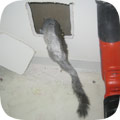 |
|
| I smelled a bad smell in this apartment, and I knew it had to be some dead varmint. I walked the house, employing a sniff. I entered the
laundry room and got a whiff. I sniffed the walls, I sniffed the ceiling, but it was the floorboard I found most appealing. I leaned on down and felt like
a hero, because I knew I'd found ground zero. I got my saw and cut out a square, and was promptly greeted with fragrant air. I reached inside and fished
around, and a squishy squirrel is what I found. I bagged it and tagged it and named it Muriel, I said a prayer & made a proper burial ...click for more |
03.23.2007 - Animal Hydration - Thirsty Armadillo
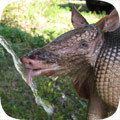 |
|
| Now here's a thirsty critter! This is a Nine-Banded Armadillo, after a day of being stuck in a trap. I usually work very hard to keep the animals cool. I set traps in the shade, I cover traps when I can, and I always retrieve the animals as early as possible.
The worst thing to do is to leave an animal in a cage all day, particularly out in the sun and without water! That is a very inhumane thing to do, and it causes the animal to suffer, and perhaps suffer heat stroke or death. It's important to get the animal removed and relocated
quickly. In a case in which I believe ...click for more |
03.17.2007 - Fight! Raccoon versus Opossum
 |
|
| Ladies and gentlemen! In the blue corner, weighing in at 11 pounds, making his debut fight, please welcome our challenger, Pete "I Don't Play Dead" Possum! And in the gold corner, weighing in at 14 pounds, our current champion, give it up for Ricky "Rocky" Raccoon! Touch paws
gentlemen, I want a good, clean fight! There's the opening bell, I expect they'll just look at each other as always AND HOLY CRAP THEY'RE ABOUT TO TEAR EACH OTHERS THROAT OUT STOP THE FIGHT STOP THE FIGHT, in goes the metal divider, and it's all over
a ...click for more |
03.16.2007 - Pigeon Disease - Diseases from Birds
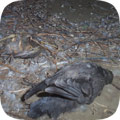 |
|
| Ever since I was a small lad, I was taught not to pick up bird feathers, as I was told they were dirty. Many birds are in fact dirty,
especially the "flying rat" or "gutter bird", also known as the pigeon. These birds often live in cities or buildings, and they make quite a mess with their
feathers, nesting material, and most of all, waste. The waste can accumulate in heavy amounts inside buildings, such as in the ceiling of the office
building pictured above. Here are some of the more serious diseases associated with bird infestation in public areas and buildings. The Histoplasmosis...click for more |
03.11.2007 - Raccoon Snare - Snaring an Animal
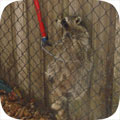 |
|
| Raccoon sure manage to get themselves into all sorts of trouble! This one somehow got itself lodged between a chain link fence and a wooden fence.
This was a really tight spot! I don't know how it happened, but this raccoon was stuck fast. We were called out to the scene. The easiest way to remove wild
animals from tight spots is usually with a snare pole - it's a pole with a plastic-coated metal cable that can tighten around the animal. Many animal control officers use
such a device. We were called out, and the property owner wanted the raccoon removed ...click for more |
03.05.2007 - America's Deadliest Snake
 |
|
| Behold! The most dangerous snake in America! The rare Hangman's Snake (constrictus dangleus). It sneaks up on you
from behind, latches itself around your neck, and then forces you to choke yourself to death! Sometimes this species gives you a chance to spell out a mystery word, but if you
fail to guess the correct letters and solve the puzzle, it attacks. If you spot this snake, stay calm and turn and walk the other way. It primarily lurks around gallows and
lynching trees, so beware when entering these habitats. Should you find yourself amidst an attack ...click for more |
03.04.2007 - Rodents Chew on Electrical Wires in the Attic
 |
|
| When I saw this wire, and several others with the same symptoms in this attic, I knew that I was dealing with some sort of rodent in the attic, and I suspected that I was dealing with rats. First of all, I saw the characteristic brown grease smudging on the wires,
which rats leave. Next, I saw many rat droppings around the wires. I also saw footprints that were clearly those of the Rattus Rattus, or Roof Rat. Finally, I saw chewing on the wire with the exact bitemarks that match the front incisors of the Roof Rat. Finally, I set some rat
traps right next to the offending wires, and ...click for more |
02.27.2007 - Raccoon Face Photograph
 |
|
| This is a photograph that I managed to take close-up of a raccoon. It was hiding in a duct, and I was able to get my camera very close. I caught this critter, so I know it was a female. But with raccoons, I can always tell anyway. Male raccoons
have a different appearance than females. The differences are subtle, but it's easy to tell, just like it's easy to tell with people. Female raccoons simply look more feminine, or even prettier, if you will.
If you spent as much time looking at raccoons as I do, you'd start to recognize the differences as well. A male has a somewhat wider ...click for more |
02.22.2007 - Do Bats Carry Rabies?
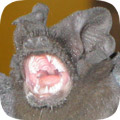 |
|
| Bats do carry rabies, as can most any mammal. Bats are of considerable importance, because they are common rabies vector species in North America. That is, most of the documented cases of rabies transmission in
the United States over the past 50 years or so are due to infection by bat. The number of cases is not high - I don't have the exact statistics, but I've read that there's about one death in the U.S. per year due to rabies
transmission from bats. This is much higher than from raccoons, skunks, or even dogs. The most likely reasons for this are ...click for more |
02.20.2007 - Squirell Control & Removal
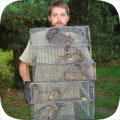 |
|
| I'm going to misspell squirrel as squirell for this blog entry, so that any internet searches searching for help with a squirrel problem might find this page.
Squirrels can cause many problem, but of course the most common is squirells in the attic. Some people have me trap and remove and relocate squirells just because they
are causing other problems outside, such as chewing on wood or stealing bird food, but most of the time, I deal with squirells inside homes. Most squirell control
revolves around trapping and removal. The nuisance squirells need to be tak ...click for more |
02.06.2007 - Armadillo Cage - Pet Armadillo?
 |
|
| The beautiful face of an armadillo. Just look at that snotty nose and those sharp claws! Who would't want an armadillo for a pet? Why,
you could just keep the armadillo in a cage or a pen, and it would be a fine and loyal companion, with all the benefits of a Golden Retriever, plus a tougher
exterior and barely any shedding. We should all have pet armadillos, right? Right. I mean wrong. I've received numerous requests over the years for armadillo
specimens to be donated as pets. The problem is that this animal isn't really suitable as a pet. At least, I don't think it is...click for more |
02.02.2007 - Animal Trapping
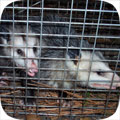 |
|
| Every now and then, while animal trapping, I get a double catch. Such was the case today, when I found two opossums in the same trap. While this was
a nice bonus, most of the time, I find no catches in my traps. Not that I'm a lousy animal trapper, but that this is the way it goes. Even the best trap set will
yield no results for a variety of reasons. Animal trapping isn't a simple matter, and a lot goes into successful trapping. I'll now outline the five primary
considerations when it comes to catching nuisance critters. Type Of Trap: Of the many wildlife traps available, ...click for more |
01.26.2007 - Pigeon Droppings & Waste in an Attic
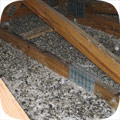 |
|
| Everyone knows that pigeons poo. You can see lots of their waste in any city in America, particularly under the areas in which they roost. However,
poop outside tends to wash away with the rain. In this case, pigeons were living inside an attic of a home, and it just doesn't rain as hard inside attics, and thus the
poop accumulated. This pigeon waste buildup happened over only a few months - or so I'm told by the customer, though the birds could have been up there longer than
suspected - and I found only five birds in the attic. I guess pigeons poop a lot! I flushed ...click for more |
01.21.2007 - Ringneck Snake Photograph
 |
|
| Here is a photo of me with a nice-sized Ringneck snake. I did not take this photo, as if often the case with photos in which
I appear. No, this photo was taken by the customer, who happens to be a professional photographer. Professionals shoot in black and white you know, which is much cooler than
boring old color. If the photo had been in color, you would have noticed the orange ring around the neck of this snake, its orange belly, and my shimmering olive green/grey
eyes, which evoke memories of the rugged Irish seas on an autumn morn. Alas, in this ...click for more |
01.19.2007 - Roof Rat Photo
 |
|
| I'm proud of this high-detail photograph that I took of a Roof Rat (rattus rattus). I caught this rat in a live cage trap, and decided that I'd do a photo shoot for the heck of it. I put the rat in the bottom of a tall white garbage can. Now, before you try
the same thing at home, I have to warn you that rats are amazingly fast, can climb almost any surface, and can really, really, really jump high. There's barely a container that can ...contain them. Only a tall unit with slick
vertical walls, at least four feet high, will do the trick. That's what I had in this case. Next, you want a rat that ...click for more |
01.14.2007 - Bat Control in Orlando, FL
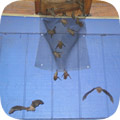 |
|
| I took this photo at a bat control project in Orlando Florida, where I live and work. It was a typical case of over 1000 Brazilian (Mexican) Free-Tail bats living in the attic of a building. I had to install
steel screens along all of the gaps around the perimeter of the structure. This case was a bit unusual in that the bats were willing to fly in and out of such large gaps. They usually prefer to fly in through tiny gaps,
often no more than a half-inch wide. I believe that the reason for this is, and I've never read any corroborating evidence to support this theory, but I believe the reason ...click for more |
01.13.2007 - Fat Raccoon
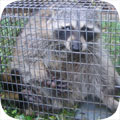 |
|
| This is one of the fattest raccoons that I've ever caught. Interestingly, in the cage on the left, out of the photo is the actual fattest raccoon that I
ever caught. However, I decided to feature only a photo of this one, because I like how it is sitting. It looks like a lazy blob, like Jaba the Hutt or something.
The one in this photograph weighed 22 pounds, and the one next to it was 29 pounds! These sizes are very large for Florida raccoons, which rarely exceed 15 pounds.
Up north, raccoons this size are more common, and can even reach up to 50 pounds, but in FL mamm ...click for more |
|


